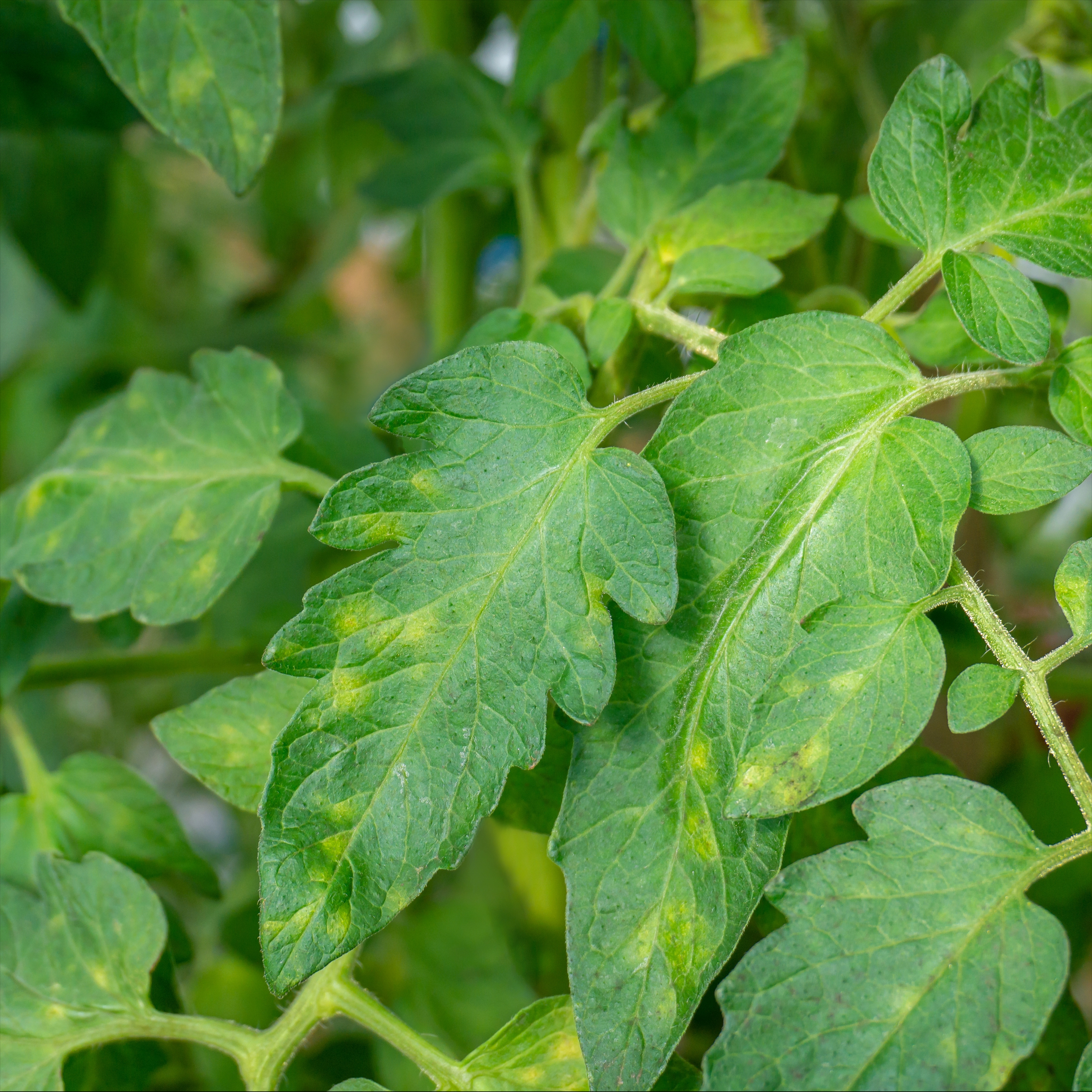
Introduction to Cladosporium fulvum
Cladosporium fulvum, an important phytopathogenic fungus, is best known for its role as the
causal agent of leaf spot disease on tomato plants.
This fungus belongs to the genus
Cladosporium, which occurs worldwide in various environmental conditions. Although
Cladosporium fulvum is mainly considered a plant pathogen, there is increasing
evidence that it can also pose health risks to humans.
Cladosporium fulvum produces spores that can be easily spread by air currents
. These spores are often found indoors and can trigger allergic reactions in sensitive individuals
. This is particularly problematic in humid environments, where
the fungus finds optimal growth conditions.
According to a study by the
World Health Organisation (WHO), mould spores, including Cladosporium
species, are present in around 20-30% of indoor spaces worldwide.
Another characteristic of Cladosporium fulvum is its ability to survive in various
climatic conditions. This makes it a ubiquitous part
of our environment, occurring in both temperate and tropical zones.
The
adaptability of this fungus contributes to the fact that it can also be found in homes, schools and
workplaces, which means an increased risk of exposure for humans.
This blog post will take a closer look at the biology and life cycle of
Cladosporium fulvum to gain a better understanding of its impact on
human health.
Biology and life cycle of Cladosporium fulvum
Cladosporium fulvum, also known as Passalora fulva, is an obligate biotrophic fungus that specialises
on tomato plants.
Its life cycle begins with the germination of conidia
(spores) that land on the leaf surface of the host plant. These conidia germinate and form
hyphae that penetrate the leaf cells to extract nutrients. In the course of infection
the fungus produces a network of hyphae that spreads through the leaf tissue and leads to the formation
of characteristic leaf spots.
A key aspect of Cladosporium fulvum's biology is its ability to produce
effector proteins that suppress the host plant's immune system.
These
effector proteins allow the fungus to spread unhindered in the plant and optimise
nutrient uptake. Studies have shown that the fungus has over 30 different
effector proteins, each of which fulfils specific functions in the infection process.
The life cycle of Cladosporium fulvum can be divided into several phases:
- Sporulation: The fungus forms conidia, which serve as spores and are spread by air currents .
- Germination: As soon as the conidia encounter a suitable host plant, they begin to germinate and form hyphae.
- Infection: The hyphae penetrate the leaf cells and begin to extract nutrients.
- Spread: The fungus spreads within the plant and forms new conidia, which can in turn be spread.
Understanding the life cycle of Cladosporium fulvum is crucial to developing effective
measures to control this fungus. Researchers are continuously
investigating the genetic and molecular mechanisms behind infection and spread,
in order to develop new strategies to control the fungus. This research is particularly
important to ensure the yield and health of tomato plants, which are an
important source of food worldwide.
Health risks of Cladosporium fulvum for people
While Cladosporium fulvum is mainly known as a plant pathogen,
research has shown that this fungus also harbours potential health risks for humans.
People with weakened immune systems, allergy sufferers and
asthmatics are particularly affected. One of the main dangers comes from the spores of the fungus, which are spread through the air
and can reach high
concentrations indoors, especially in humid environments.
Allergic reactions and respiratory diseases
Cladosporium fulvum is known to cause allergic reactions. The spores can
cause symptoms such as sneezing, coughing, watery eyes and itching when inhaled. In
severe cases, asthmatic symptoms can occur. According to a study by the
American Academy of Allergy, Asthma & Immunology (AAAAI), mould spores,
including Cladosporium species, are one of the most common causes of seasonal allergies.
Infections in immunocompromised individuals
For people with a weakened immune system, such as HIV patients or people taking immunosuppressive medication,
Cladosporium fulvum can pose a serious
risk. Cases have been documented in which the fungus has caused invasive infections
that are difficult to treat. These infections can affect various organs
and are often life-threatening.
Skin and nail infections
Cladosporium fulvum can also cause skin and nail infections, especially in
people who work a lot with soil or plants. These infections are often persistent and
require prolonged treatment with antimycotics.
Prevalence and sources of exposure
Studies have shown that Cladosporium species can be found in about 20-30% of indoor spaces worldwide
, especially in damp and poorly ventilated areas such as bathrooms and
basements. The fungus can also grow in ventilation systems and on air conditioning filters, which favours the
spread of spores indoors.
Given these risks, it is important to take measures to reduce exposure to
Cladosporium fulvum. These include regular cleaning and maintenance of
ventilation systems, avoiding moisture build-up and using
air filters.
Symptoms and diagnosis of Cladosporium infections
The symptoms of Cladosporium infections can vary greatly depending on the type of exposure and the
individual's susceptibility. The symptoms primarily affect the respiratory tract
and the skin, which is particularly problematic for people with weakened immune systems or existing
allergies.
Respiratory symptoms
Cladosporium fulvum can cause a range of respiratory symptoms
when spores are inhaled. The most common symptoms include:
- sneezing
- coughing
- shortness of breath
- wheezing
- exacerbation of asthma
According to a study by the American Lung Association, people who are regularly exposed to
Cladosporium spores show an increased prevalence of chronic
respiratory diseases. These symptoms may be particularly exacerbated in seasonal allergy sufferers during
the fungal spore season.
Skin and nail symptoms
In addition to the respiratory tract, Cladosporium fulvum can also affect the skin and nails. The
symptoms include:
- itching
- redness
- skin rashes
- discolouration and thickening of the nails
These symptoms are more common in people who have close contact with contaminated soil
or plants, such as gardeners.
Diagnostic methods
Cladosporium infections are usually diagnosed by a combination of
clinical examination and laboratory tests.
Common diagnostic methods include:
- Microscopic examination: skin or mucous membrane samples are examined for the presence of fungal spores.
- Culture: Cultivation of the fungus from sample material to identify the specific pathogen .
- Molecular tests: PCR tests can detect specific DNA sequences of Cladosporium fulvum and thus enable an accurate diagnosis.
An early and accurate diagnosis is crucial in order to be able to initiate appropriate treatment measures
and avoid complications. Therefore, people who show persistent
symptoms should consult a doctor immediately.
Treatment and prevention of Cladosporium infections
The treatment and prevention of Cladosporium infections is crucial to minimise the
health risks that this fungus poses to humans. Particularly
at risk are those with weakened immune systems, allergy sufferers and those who live or work in humid
environments. Here are some proven strategies for treating and
preventing Cladosporium infections:
Treatment
- Drug therapy: The treatment of Cladosporium infections is usually with antifungal drugs. These drugs can be administered topically for skin and nail infections or systemically for more severe cases. Frequently used antimycotics are fluconazole and itraconazole.
- Symptom relief: For allergic reactions and respiratory illnesses, antihistamines and corticosteroids can be used to relieve symptoms. These medications help to reduce inflammation and improve the quality of life of those affected .
- Surgical interventions: In rare and severe cases, particularly with invasive infections, surgery may be required to remove infected tissue.
Prevention
- Improve air quality: Installing HEPA filters in ventilation systems can significantly reduce the concentration of mould spores indoors. Regular maintenance and cleaning of air conditioning systems and humidifiers are also important.
- Humidity control: As Cladosporium fulvum thrives in humid environments, it is important to control indoor humidity levels. Using dehumidifiers and fixing water leaks can prevent the growth of the fungus.
- Hygiene and cleaning: Regular cleaning of surfaces, especially in bathrooms and kitchens, can reduce mould growth. Use mould-killing cleaning products to ensure that spores are effectively removed.
- Protective measures for vulnerable people: People with weakened immune systems should avoid contact with potentially contaminated materials. Wearing gloves and protective clothing when gardening can reduce the risk of skin and nail infections. Following these measures can help minimise exposure to Cladosporium fulvum at and reduce the risk of infections and allergic reactions.
Conclusion and future research perspectives
Cladosporium fulvum poses a significant threat to both plants and humans
. While the control of this fungus in tomato plants is well researched,
the importance for human health is increasingly becoming the focus of scientific attention.
The health risks of Cladosporium fulvum for humans, especially in terms of
allergic reactions and infections in immunocompromised individuals, should not be underestimated.
Important findings and challenges
The research results to date show that the spores of Cladosporium fulvum are present in many
indoor spaces and can lead to health problems
in susceptible individuals. This emphasises the need to develop effective prevention and
treatment methods. Despite progress in diagnosis and treatment
, many questions remain unanswered, particularly with regard to long-term exposure and the
development of resistance to antimycotics.
Future prospects
Future research should focus on several key areas:
- Genetic and molecular mechanisms: a deeper understanding of the genetic and molecular mechanisms that control the infection and spread of Cladosporium fulvum, could enable new approaches to combat the fungus. This includes, in particular, research into the effector proteins and their interaction with the host's immune system.
- Improved diagnostic methods: The development of rapid and reliable diagnostic methods, such as advanced molecular tests, could improve the early detection and treatment of Cladosporium infections.
- Prevention strategies: Effective prevention strategies to reduce exposure to Cladosporium fulvum, especially indoors, are essential. This includes improving air quality and controlling humidity.
- Public education: Educating the public about the risks of Cladosporium fulvum and the importance of hygiene and regular maintenance of ventilation systems can help reduce exposure risks.
Through continued research and collaboration between academia and
health authorities, the health effects of Cladosporium fulvum on
people can be better understood and controlled. This will ultimately help to improve the
quality of life of affected individuals and raise general awareness of the
importance of this fungus.
Source list
- https://www.zkbs-online.de/ZKBS/SharedDocs/Downloads/01_Allgemeine %20Statements/05%20Fungi/Cladosporium_fulvum_2006.pdf?__blob=publicationFile&v=4
- https://www.thermofisher.com/allergy/de/de/allergen-fact-sheets/cladosporium-herbarum.html
- https://digitalcollection.zhaw.ch/handle/11475/25215, https://de.wikipedia.org/wiki/ Cladosporium
- https://www.jstor.org/stable/23841636, https://www.dr-friese.de/medizinischeinformationen- allergien-im-haus/
- https://www.bio-gaertner.de/pflanzenkrankheiten/ Velvet spot disease
- https://digitalcollection.zhaw.ch/ bitstream/11475/25215/1/2022_Odermatt_Silvia_BA_UI.pdf
- https://books.google.de/books? id=x6qJri5JcrgC&pg=PA70&lpg=PA70&dq=cladosporium+fulvum+in+relation+to +people&source=bl&ots=nzjTp9ap2e&sig=ACfU3U16Y7etWbxMwsHP4lfg4z2R75mxUw&hl= de&sa=X&ved=2ahUKEwiHxePjq7CGAxVdNzQIHfbcAtYQ6AF6BAgLEAE
Become a member now
As a member, you will receive further information and frequencies on this topic! Log in here!


